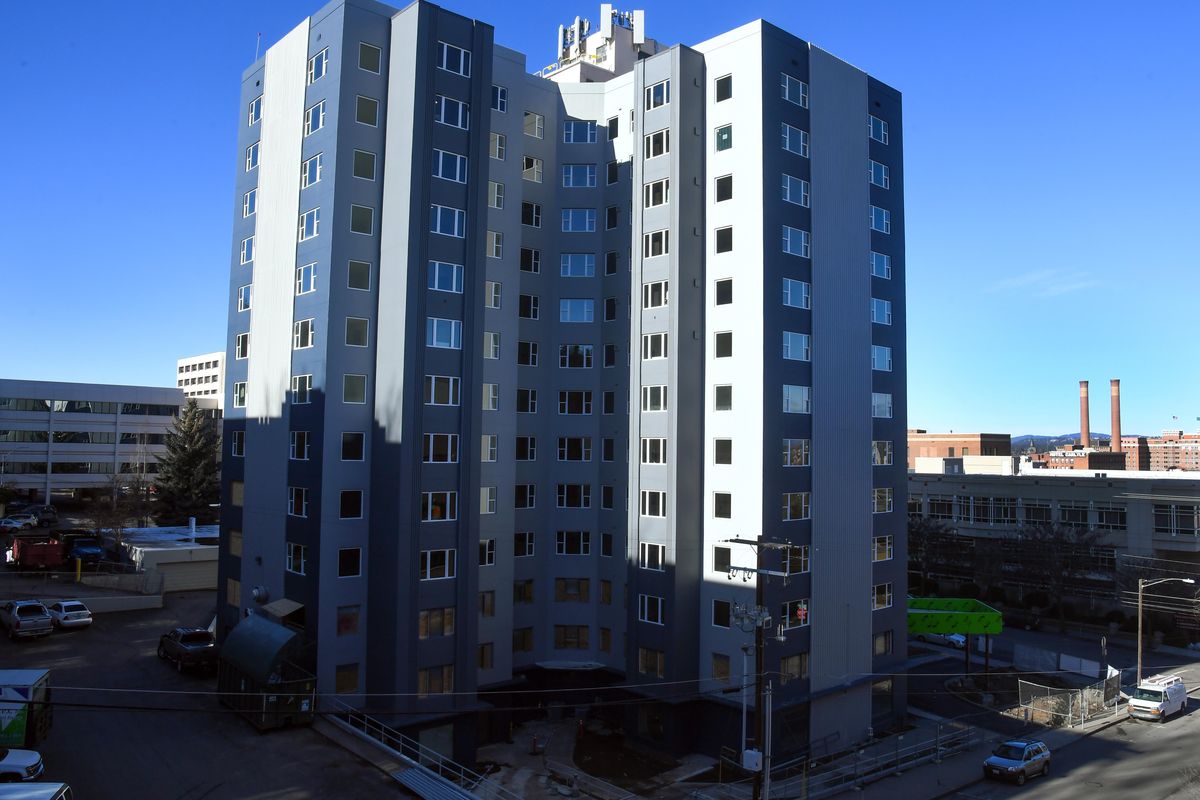Central Spokane’s Cooper-George Apartments get $7.5 million upgrade

The $7.5 million transformation of Spokane’s first luxury senior apartment community into “big city downtown living” is nearly complete at the Cooper-George Apartments, a midcentury high-rise at the base of the South Hill.
The 144 units in the 13-story building, which recently acted as assisted-living housing for older folks on Medicaid, will soon be available at market-rate rents, aimed at professionals seeking an urban lifestyle.
“We’re trying to promote the use of mass transportation, biking, ride shares,” said Jeb Koerner, one of the building’s three Oregon-based owners. “We’ve got Amazon lockers in the basement.”
Koerner, who is based in Portland, anticipated the building would be ready for tenants in April, a delay from the original February deadline.
The building’s other owners are Dave Montagne, a Salem-based developer of apartment complexes, and Kevin Ricker, of Portland. The three purchased the building at 707 W. Fifth Avenue last year for $5.5 million, though Ricker had been a part owner of the building for a number of years.
The “head-to-toe remodel, inside, outside” has given the formerly beige, 66-year-old building an updated feel. Now, contrasting blue and gray surfaces frame gleaming new windows.
Koerner said the units have been remodeled with new flooring, cabinets and walls, fresh paint, brand new appliances and quartz counter tops. Each apartment has a gas range and a new washer and dryer.
“You’re probably not going to be able to tell that these are the units we started with,” Koerner said. He estimated rents would start at $750 but said they weren’t yet set.
The new Cooper-George aims at less auto-oriented tenants, Koerner said, noting that the relative lack of parking spaces is partially responsible for that goal.
“We have 100 vehicle stalls and 144 units,” he said, pointing to a parking garage across the street and a surface lot out back. “We’ll have space for 100 bikes downstairs.”
Bike facilities in the building will include a mechanic station and bike washing station.
“We really want to promote that lifestyle,” Koerner said.
The building also will have a private gym and rooftop deck reserved for tenants. A retail space on the building’s first floor could house a cafe, said Koerner, and the building’s owners are in talks with local hospitals for corporate apartments, to house visiting executives.
Montagne said “it was the opportunity with the building” that brought his attention as a developer to Spokane.
“It’s a beautiful building,” Montagne said. “When it was built, it was considered one of the nicer ones on the West Coast. We decided to bring that back, but it needed some tender loving care.”
Cooper-George was designed by the renowned architectural company Whitehouse & Price. The Spokane-based firm is best known for the Cathedral of St. John the Evangelist on the South Hill’s Grand Avenue, but is also responsible for the Lincoln Building downtown, the Benewah Milk Bottle in the Garland Business District and Eastern State Hospital.
According to MidcenturySpokane.org, the luxury apartments, which were developed by investment broker J.L. Cooper and construction contractor Henry George, drew about 16,000 people to its March 16, 1952, grand opening.
At its opening, which preceded the construction of Interstate 90 by 15 years, the building had two dining rooms, a grocery store, dry cleaners, a beauty shop and a doctor’s office.
Looking back decades later, in 1996 Spokesman-Review columnist Frank Bartel called the Cooper-George “the creme de la creme of apartment dwellings in this corner of the world.” He said the “building’s directory read like a social register of Spokane at midcentury.”
Forty years after its opening, the Cooper-George faced a new future as it was renovated into a retirement and assisted living facility and renamed South Hill Senior Living. Its tenant population shifted toward those who received financial support from the state.
Last February, when the new owners told the state it was surrendering its license to operate a senior care facility, 94 percent of its assisted-living tenants received Medicaid benefits. The facility had 90 days to find new homes for its tenants, which was done with assistance by the state Department of Social and Health Services.
Chris Wright, a spokesman with the department’s Aging and Long-Term Support Administration, said DSHS found housing “placements as close to where they want to live as possible.”
At its closure, the facility’s executive director, LeAne Austin, a registered nurse, said business operation and staff costs had risen significantly in the past decade. Additionally, while assisted living units were generally filled, those for independent seniors on the upper floors had more vacancies.